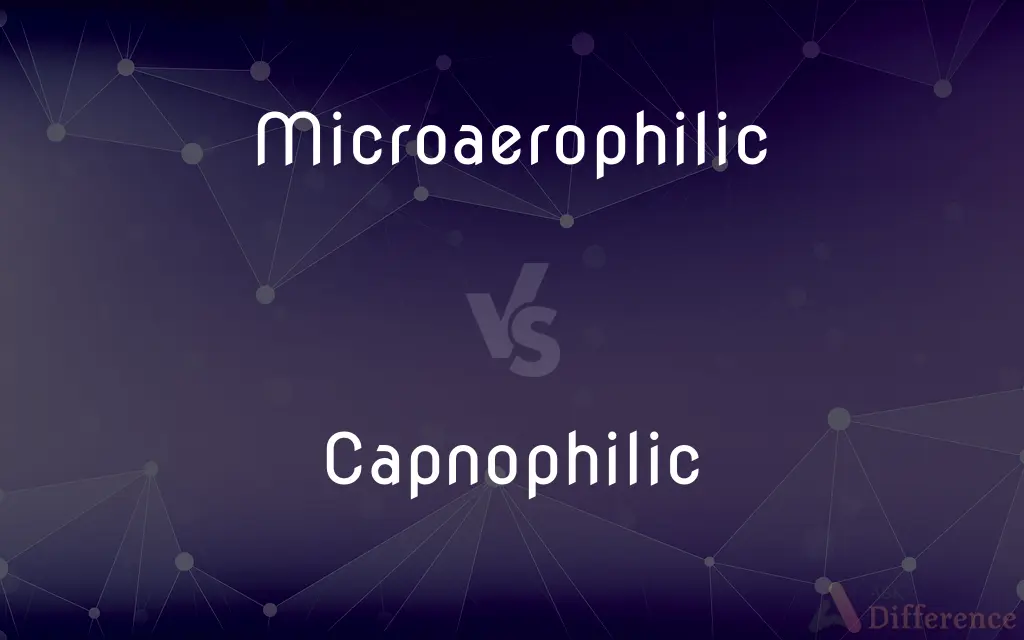Microaerophilic vs. Capnophilic — What's the Difference?
By Urooj Arif & Fiza Rafique — Updated on March 20, 2024
Microaerophilic organisms require low oxygen levels, while capnophilic organisms thrive in high carbon dioxide environments.

Difference Between Microaerophilic and Capnophilic
Table of Contents
ADVERTISEMENT
Key Differences
Microaerophilic organisms are adapted to survive in environments where oxygen is present but at lower levels than in the atmosphere. These conditions are not enough to sustain most aerobic organisms but are too oxygen-rich for anaerobic organisms. Capnophilic organisms, on the other hand, require environments with a higher concentration of carbon dioxide (CO2) than is typically found in the atmosphere. These conditions are often artificially created in laboratory settings to cultivate certain bacteria, such as those in the human respiratory tract.
While microaerophilic organisms have evolved mechanisms to minimize oxygen toxicity and utilize the small amounts available for their metabolic needs, capnophilic organisms often use carbon dioxide in their metabolic processes. This adaptation is seen in some bacteria that are part of the human flora, where they contribute to the breakdown of organic compounds.
The cultivation of microaerophilic organisms in the laboratory requires creating an environment with reduced oxygen levels, often through the use of specialized equipment or chemical packets that absorb oxygen. This is critical for studying organisms that cause diseases in oxygen-limited tissues, like the gastric lining.
In contrast, capnophilic organisms are cultivated in environments enriched with carbon dioxide, often using CO2 incubators or candle jars that increase the CO2 concentration. This is particularly important for isolating and studying bacteria from body sites like the gastrointestinal tract, where CO2 levels are naturally higher. The distinction between microaerophilic and capnophilic organisms highlights the diversity of life and its ability to adapt to a wide range of environmental conditions, each exploiting different ecological niches based on their unique metabolic needs and tolerances.
Comparison Chart
Preferred Gas
Low oxygen levels
High carbon dioxide levels
ADVERTISEMENT
Typical Environments
Soil layers, water bodies, human stomach
Human respiratory tract, gastrointestinal tract
Metabolic Adaptation
Minimizes oxygen toxicity, uses oxygen at low levels
Utilizes carbon dioxide in metabolic processes
Laboratory Cultivation
Reduced oxygen environments
Carbon dioxide-enriched environments
Example Organisms
Helicobacter pylori
Haemophilus influenzae
Compare with Definitions
Microaerophilic
Requiring low oxygen for growth.
The microaerophilic bacteria thrived in the oxygen-reduced environment of the sealed jar.
Capnophilic
Thriving in high carbon dioxide environments.
The capnophilic microorganisms are commonly found in the human gut where CO2 levels are elevated.
Microaerophilic
Adapted to low oxygen levels.
The microaerophilic organisms have evolved mechanisms to tolerate reduced oxygen.
Capnophilic
Requiring high carbon dioxide for growth.
Capnophilic bacteria showed optimal growth in the CO2 incubator.
Microaerophilic
Thriving in environments with reduced oxygen.
Certain microaerophilic species are found in the digestive tracts of animals.
Capnophilic
Adapted to high CO2 concentrations.
Capnophilic cultures are essential for studying certain respiratory pathogens.
Microaerophilic
Not surviving in atmospheric oxygen levels.
Microaerophilic fungi failed to grow when exposed to normal air.
Capnophilic
Not thriving in normal atmospheric conditions.
The capnophilic bacteria did not grow well without supplemental carbon dioxide.
Microaerophilic
Sensitive to high oxygen concentrations.
The laboratory cultivated the microaerophilic cells under carefully controlled oxygen conditions.
Capnophilic
Utilizing carbon dioxide in metabolic processes.
The capnophilic species use CO2 to synthesize organic compounds.
Microaerophilic
Of or relating to a microaerophile or to microaerophily.
Capnophilic
Thriving in the presence of carbon dioxide.
Microaerophilic
Able to thrive in an environment low in oxygen.
Common Curiosities
How do microaerophilic organisms adapt to low oxygen?
They have evolved mechanisms to minimize oxygen toxicity and utilize the small amounts of oxygen available efficiently.
Where can microaerophilic organisms be found?
They can be found in various environments like certain soil layers, water bodies, or as part of human flora, such as in the stomach.
What are microaerophilic organisms?
Microaerophilic organisms are those that require low oxygen levels for growth, less than atmospheric concentration.
What does capnophilic mean?
Capnophilic refers to organisms that thrive in environments with high carbon dioxide levels.
What are the implications of microaerophilic organisms in food preservation?
Their growth in low-oxygen environments can affect food preservation strategies, requiring careful control of oxygen levels.
How are capnophilic organisms cultured in a lab?
They are cultured in environments enriched with carbon dioxide, using CO2 incubators or candle jars.
What is the significance of microaerophilic bacteria in medicine?
Microaerophilic bacteria are significant in medicine as they can cause diseases in oxygen-limited tissues, such as the gastric lining.
Why are some bacteria capnophilic?
Some bacteria are capnophilic because they have adapted to or require high carbon dioxide levels for their metabolic processes.
Can capnophilic bacteria cause diseases?
Yes, some capnophilic bacteria can cause diseases, especially those that thrive in the respiratory or gastrointestinal tracts.
What are the challenges in studying microaerophilic organisms?
The main challenge is creating and maintaining the required low-oxygen environments for their cultivation and study.
How do capnophilic organisms affect human health?
They can impact human health by being part of the normal flora or by causing infections, especially in the respiratory and gastrointestinal tracts.
How do capnophilic organisms contribute to the human flora?
They contribute by being part of the normal flora in regions like the gastrointestinal tract, aiding in the breakdown of organic compounds.
What research is being done on microaerophilic and capnophilic organisms?
Research focuses on understanding their metabolic processes, ecological niches, and roles in human health and disease.
Are all bacteria either microaerophilic or capnophilic?
No, bacteria can be aerobic, anaerobic, microaerophilic, or capnophilic, depending on their oxygen and carbon dioxide requirements.
Can an organism be both microaerophilic and capnophilic?
Yes, some organisms may require low oxygen and high carbon dioxide levels, adapting to both conditions.
Share Your Discovery

Previous Comparison
Software vs. Program
Next Comparison
Polymer vs. ElastomerAuthor Spotlight
Written by
Urooj ArifUrooj is a skilled content writer at Ask Difference, known for her exceptional ability to simplify complex topics into engaging and informative content. With a passion for research and a flair for clear, concise writing, she consistently delivers articles that resonate with our diverse audience.
Co-written by
Fiza RafiqueFiza Rafique is a skilled content writer at AskDifference.com, where she meticulously refines and enhances written pieces. Drawing from her vast editorial expertise, Fiza ensures clarity, accuracy, and precision in every article. Passionate about language, she continually seeks to elevate the quality of content for readers worldwide.
















































